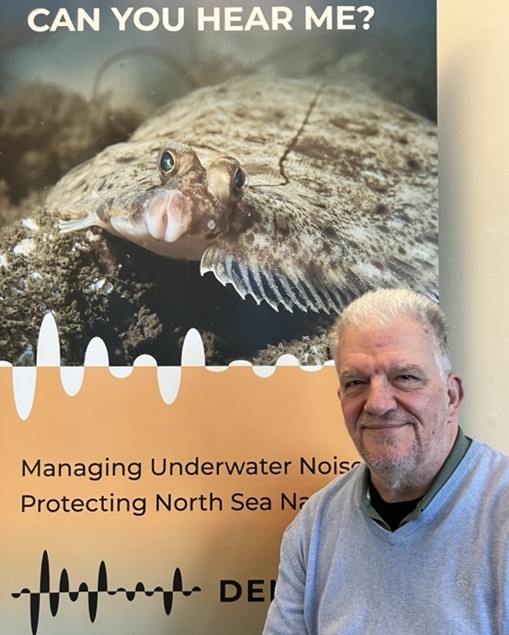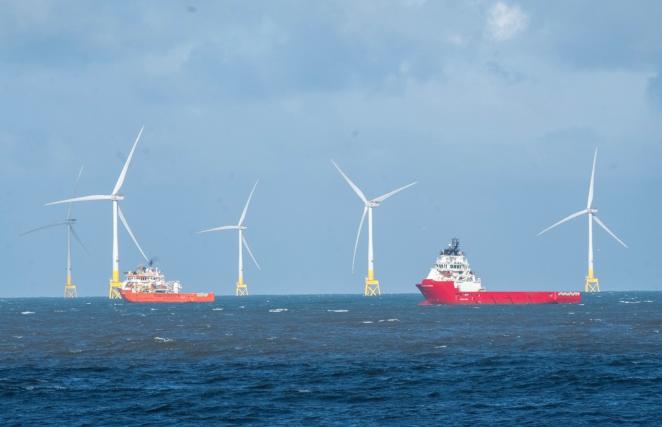Progress, challenges and future goals in tackling underwater noise pollution
The Interreg project DEMASK has now been running for a year, marking the perfect moment to look back on previous milestones and forward to the challenges and ambitions that lie ahead. What progress has been made in addressing underwater noise pollution? And, most importantly, what are the next steps? To gain insight, we spoke with Niels Kinneging, project manager of DEMASK and expert at Rijkswaterstaat.

DEMASK Project Manager
Can you tell us about your role in DEMASK?
“As the project manager of both JOMOPANS and DEMASK, I am involved from the start. With a background as a physicist, I have a strong interest in underwater sound. I find this field especially exciting because it remains relatively new, with many aspects still taking shape in terms of underlying concepts and approaches. Sound is a physical phenomenon, and what makes DEMASK particularly fascinating for me is its focus on the interaction between sound, biology, and ecology,” Niels explains. “I enjoy collaborating with experts from various disciplines, and it’s great to see how the nine partners – institutes from different North Sea countries – bring together diverse knowledge and experience. Seeing everyone's dedication and enthusiasm makes my role as project leader much easier.”
Underwater noise pollution has only relatively recently been recognised as an environmental issue, gaining attention after being classified as a form of pollution under the European Marine Strategy Framework Directive. “It’s rewarding to contribute to putting this issue on the map,” says Niels.
Why is tackling underwater noise pollution important?
“Underwater noise pollution is recognised as a real problem. For marine animals sound is of vital importance to communicate or to find prey. With too much noise communication is disturbed and prey is harder to find. Therefore, we need to take action. Our goal is to reduce pollution and minimise its impact on marine life. However, to do this, we must follow a structured approach. In the JOMOPANS project, we focused on measuring and mapping underwater sound: how much is there, and where? We also studied its effects on marine animals. With DEMASK, we go further by exploring possible solutions,” explains Niels.
DEMASK focuses on developing recommendations for responsible policies to reduce underwater noise pollution. A key challenge in this process is balancing the interests of various stakeholders of different countries. “There are many parties involved: from governments and industries to environmental organisations. Finding solutions that work for everyone is what makes this project so fascinating,” Niels adds.

What has DEMASK achieved in its first year?
After a year of research, DEMASK has already achieved significant progress. Various scenarios have been developed to address the impact of expanding offshore wind farms and increasing shipping traffic, providing a foundation for actionable policy recommendations. Initial calculations for these scenarios are underway. Additionally, strong connections have been established with key stakeholders from multiple sectors. Niels concludes: “Over the past year, we have held numerous meetings with different stakeholders, from the maritime industry to NGOs. Understanding their perspectives and the measures already in place for underwater noise management is important for developing effective policies. Another milestone of the project has been the development of an assessment tool to identify which marine species are most vulnerable to underwater noise pollution. This tool helps prioritise conservation efforts, ensuring that the marine species most at risk receive the necessary attention and protection.”
What are the goals for the coming years?
While the first concrete results are already emerging, there is still work ahead. In the second and third years of the project, the focus will shift to refining the scenarios, conducting calculations, and translating the findings into actionable recommendations. “By the end of this year, I hope we will have a comprehensive set of scenarios and results. If we choose a particular course of action, what does that mean for underwater sound? The next step is to convert this knowledge into concrete advice: how should industries manage underwater noise? What role can governments play? Which measures are feasible for port companies, and which are not? This will help stakeholders prioritise their efforts effectively. When we reach the third year and finalise our recommendations, that will be a ‘champagne moment’ for DEMASK. But that’s just the beginning. The next phase is about implementation: policymakers must act, measures need to be tested, and we have to evaluate whether they truly reduce underwater noise,” Niels concludes.
How can awareness of underwater noise pollution be sustained?
“It’s important to remain engaged with stakeholders. We want to continue raising awareness among them and ensure that this issue gets the attention it deserves. Underwater noise pollution might not be the most urgent environmental problem, and there are other forms of pollution in the sea, such as chemical pollution. However, it is very real, even though it remains invisible. I think it’s important that it remains part of the broader environmental conversation. To keep the momentum going, DEMASK will continue publishing findings, presenting them at conferences and facilitating discussions. We invite experts, policymakers, and industry leaders to engage with our research and share their insights.”
A call to action for the future. The sounds we introduce into the ocean have unseen consequences. The choices we make today will shape the underwater world of tomorrow. Will we listen before it’s too late?
Those interested in staying informed can visit our website, subscribe to our newsletter or follow us on LinkedIn for updates!
